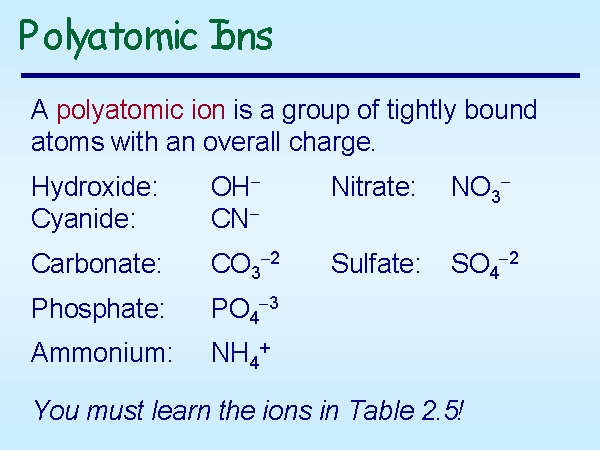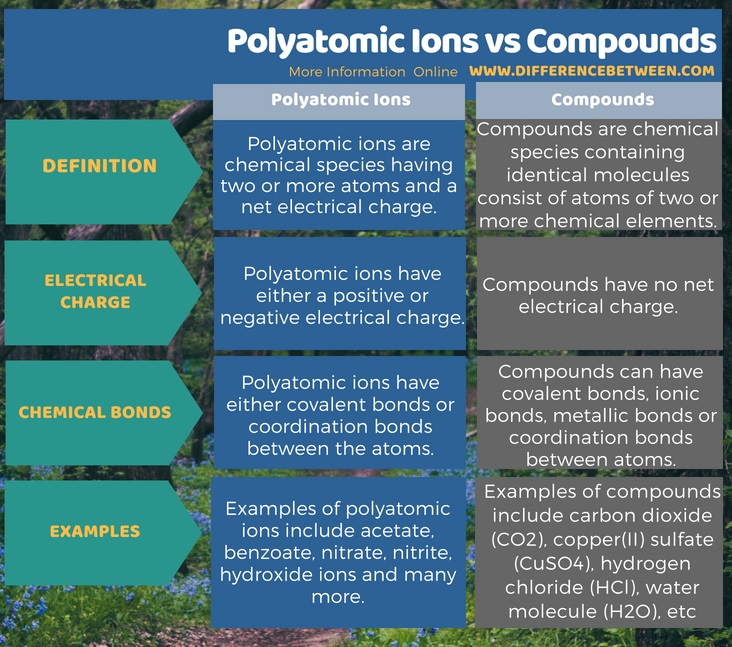Learning Objective
Link to Interactive Transitional Metal Polyatomic Ions.inorganic polyatomic –ate ion which does not have 3 or 4 oxygen atoms: Cyanate CNO 1 - Acetate CH 3 COO −. Polyatomic ions are formed when a group of atoms have a charge. Hydroxide, for example, is formed when oxygen and hydrogen covalently bond but still have a charge of -1. When a polyatomic ion forms an ionic bond with another ion, a polyatomic ionic compound is made. For example, the +1 barium ion can form an ionic bond with the -1 hydroxide ion, to form the Barium Hydroxide (BaOH) ionic compound.
- Enter polyatomic ions. Here’s the thing: If you look at a lot of the videos, tips, and advice all over the web, it all offers you either a simple mnemonic about Nick The Baby Camel – which only helps you learn a few of the polyatomic ions, or another complicated schema for converting from the “ate” polyatomic ions to the other ones.
- Does the number of normal modes in the vibrational spectra of your assigned polyatomic molecules (with N atoms) match you expectation? State the number of vibrational modes in both spectra and explain your expectation. From the spectrum you have been provided, identify whether a. All the optically-active vibrations have been observed b.
- Convert between the structure of an acid or base and its chemical name
Key Points
- Acids are named based on their anion — the ion attached to the hydrogen. In simple binary acids, one ion is attached to hydrogen. Names for such acids consist of the prefix “hydro-“, the first syllable of the anion, and the suffix “-ic”.
- Complex acid compounds have oxygen in them. For an acid with a polyatomic ion, the suffix “-ate” from the ion is replaced with “-ic.”
- Polyatomic ions with one extra oxygen (as compared to the typical polyatomic ion) have the prefix “per-” and the suffix “-ic.”
- Polyatomic ions with one fewer oxygen have the suffix “-ous”; ions with two fewer have the prefix “hypo-” and the suffix “-ous.”
- Strong bases with “-OH” (hydroxide) groups are named like ionic compounds. Weak bases are named like molecular compounds or organic compounds.
Term
- polyatomic ionA charged species (ion) composed of two or more atoms covalently bonded. Also known as a molecular ion.
Naming Acids
Acids are named by the anion they form when dissolved in water. Depending on what anion the hydrogen is attached to, acids will have different names.
Simple acids, known as binary acids, have only one anion and one hydrogen. These anions usually have the ending “-ide.” As acids, these compounds are named starting with the prefix “hydro-,” then adding the first syllable of the anion, then the suffix “-ic.” For example, HCl, which is hydrogen and chlorine, is called hydrochloric acid.
More complex acids have oxygen in the compound. There is a simple set of rules for these acids.
- Any polyatomic ion with the suffix “-ate” uses the suffix “-ic” as an acid. So, HNO3 will be nitric acid.
- When you have a polyatomic ion with one more oxygen than the “-ate” ion, then your acid will have the prefix “per-” and the suffix “-ic.” For example, the chlorate ion is ClO3–. Therefore, HClO4 is called perchloric acid.
- With one fewer oxygen than the “-ate” ion, the acid will have the suffix “-ous.” For example, chlorous acid is HClO2.
- With two fewer oxygen than the “-ate” ion, the prefix will be “hypo-” and the suffix will be “-ous.” For example, instead of bromic acid, HBrO3, we have hypobromous acid, HBrO.
Naming Bases
Most strong bases contain hydroxide, a polyatomic ion. Therefore, strong bases are named following the rules for naming ionic compounds. For example, NaOH is sodium hydroxide, KOH is potassium hydroxide, and Ca(OH)2 is calcium hydroxide. Weak bases made of ionic compounds are also named using the ionic naming system. For example, NH4OH is ammonium hydroxide.
Weak bases are also sometimes molecular compounds or organic compounds because they have covalent bonds. Therefore, they are named following the rules for molecular or organic compounds. For example, methyl amine (CH3NH2) is a weak base. Some weak bases have “common” names. For example, NH3 is called ammonia; its name isn’t derived from any naming system.
 Show Sources
Show SourcesBoundless vets and curates high-quality, openly licensed content from around the Internet. This particular resource used the following sources:
http://www.boundless.com/
Boundless Learning
CC BY-SA 3.0.
http://en.wikipedia.org/wiki/polyatomic%20ion
Wikipedia
CC BY-SA 3.0.
http://en.wiktionary.org/wiki/anion
Wiktionary
CC BY-SA 3.0.
http://en.wikipedia.org/wiki/Naming_ionic_compounds%23Naming_acids
Wikipedia
CC BY-SA 3.0.
http://en.wikibooks.org/wiki/Chemistry_Friends/Acids_and_Bases%23Naming_Acids
Wikibooks
CC BY-SA 3.0. Download ekey biometric usb devices driver.
http://www.chem1.com/acad/webtext/intro/int-5.html#SEC3
CC BY-SA.
3). Areas coloured translucent red, around the outside of the red oxygen atoms themselves, signify the regions of most negative electrostatic potential.
A polyatomic ion, also known as a molecular ion, is a covalently bonded set of two or more atoms, or of a metal complex, that can be considered to behave as a single unit and that has a net charge that is not zero. Unlike a molecule, which has a net charge of zero, this chemical species is an ion. (The prefix poly- carries the meaning 'many' in Greek, but even ions of two atoms are commonly described as polyatomic.)
In older literature, a polyatomic ion may instead be referred to as a radical (or less commonly, as a radical group). (In contemporary usage, the term radical refers to various free radicals, which are species that have an unpaired electron and need not be charged.) Ali others driver download for windows 10.
A simple example of a polyatomic ion is the hydroxide ion, which consists of one oxygen atom and one hydrogen atom, jointly carrying a net charge of −1; its chemical formula is OH−
. In contrast, an ammonium ion consists of one nitrogen atom and ‘’four’’ hydrogen atoms, with a charge of +1; its chemical formula is NH+
4.
Polyatomic ions often are useful in the context of acid–base chemistry and in the formation of salts.
Often, a polyatomic ion can be considered as the conjugate acid or base of a neutral molecule. For example, the conjugate base of sulfuric acid (H2SO4) is the polyatomic hydrogen sulfateanion (HSO−
4). The removal of another hydrogen ion produces the sulfate anion (SO2−
4).
Nomenclature of polyatomic anions[edit]
There are two 'rules' that can be used for learning the nomenclature of polyatomic anions. First, when the prefix bi is added to a name, a hydrogen is added to the ion's formula and its charge is increased by 1, the latter being a consequence of the hydrogen ion's +1 charge. An alternative to the bi- prefix is to use the word hydrogen in its place: the anion derived from H+
+ CO2−
3, HCO−
3, can be called either bicarbonate or hydrogencarbonate.
Most of the common polyatomic anions are oxyanions, conjugate bases of oxyacids (acids derived from the oxides of non-metallic elements). For example, the sulfate anion, SO2−
4, is derived from H
2SO
4, which can be regarded as SO
3 + H
2O.
The second rule looks at the number of oxygens in an ion. Consider the chlorineoxyanion family:
| oxidation state | −1 | +1 | +3 | +5 | +7 |
|---|---|---|---|---|---|
| anion name | chloride | hypochlorite | chlorite | chlorate | perchlorate |
| formula | Cl− | ClO− | ClO− 2 | ClO− 3 | ClO− 4 |
| structure |
First, think of the -ate ion as being the 'base' name, in which case the addition of a per- prefix adds an oxygen. Changing the -ate suffix to -ite will reduce the oxygens by one, and keeping the suffix -ite and adding the prefix hypo- reduces the number of oxygens by one more. In all situations, the charge is not affected. The naming pattern follows within many different oxyanion series based on a standard root for that particular series. The -ite has one less oxygen than the -ate, but different -ate anions might have different numbers of oxygen atoms.
These rules do not work with all polyatomic anions, but they do work with the most common ones. Following table give examples for some of these common anion groups.
| bromide | hypobromite | bromite | bromate | perbromate |
| Br− | BrO− | BrO− 2 | BrO− 3 | BrO− 4 |
| Iodide | Hypoiodite | Iodite | Iodate | periodate |
| I− | IO− | IO− 2 | IO− 3 | IO− 4 or IO5− 6 |
| sulfide | hyposulfite | sulfite | sulfate | persulfate |
| S2− | S 2O2− 2 | SO2− 3 | SO2− 4 | SO2− 5 |
| selenide | hyposelenite | selenite | selenate | |
| Se2− | Se 2O2− 2 | SeO2− 3 | SeO2− 4 | |
| telluride | hypotellurite | tellurite | tellurate | |
| Te2− | TeO2− 2 | TeO2− 3 | TeO2− 4 | |
| nitride | hyponitrite | nitrite | nitrate | |
| N3− | N 2O2− 2 | NO− 2 | NO− 3 | |
| phosphide | hypophosphite | phosphite | phosphate | perphosphate |
| P3− | H 2PO− 2 | PO3− 3 | PO3− 4 | PO3− 5 |
| arsenide | hypoarsenite | arsenite | arsenate | |
| As3− | AsO3− 2 | AsO3− 3 | AsO3− 4 |
Other examples of common polyatomic ions[edit]
The following tables give additional examples of commonly encountered polyatomic ions. Only a few representatives are given, as the number of polyatomic ions encountered in practice is very large.

| Tetrahydroxyborate | B(OH)− 4 |
| Acetylide | C2− 2 |
| Ethoxide or ethanolate | C 2H 5O− |
| Acetate or ethanoate | CH 3COO− or C 2H 3O− 2 |
| Benzoate | C 6H 5COO− or C 7H 5O− 2 |
| Citrate | C 6H 5O3− 7 |
| Carbonate | CO2− 3 |
| Oxalate | C 2O2− 4 |
| Cyanide | CN− |
| Chromate | CrO2− 4 |
| Dichromate | Cr 2O2− 7 |
| Bicarbonate or hydrogencarbonate | HCO− 3 |
| Hydrogen phosphate | HPO2− 4 |
| Dihydrogen phosphate | H 2PO− 4 |
| Hydrogen sulfate or bisulfate | HSO− 4 |
| Manganate | MnO2− 4 |
| Permanganate | MnO− 4 |
| Azanide or amide | NH− 2 |
| Peroxide | O2− 2 |
| Hydroxide | OH− |
| Bisulfide | SH− |
| Thiocyanate | SCN− |
| Silicate | SiO2− 4 |
| Thiosulfate | S 2O2− 3 |
| Onium ions | Carbenium ions | Others | |||
|---|---|---|---|---|---|
| Guanidinium | C(NH 2)+ 3 | Tropylium | C 7H+ 7 | Mercury(I) | Hg2+ 2 |
| Ammonium | NH+ 4 | Triphenylcarbenium | (C 6H 5) 3C+ | ||
| Phosphonium | PH+ 4 | cyclopropenium | C 3H+ 3 | ||
| Hydronium | H 3O+ | ||||
| Fluoronium | H 2F+ | ||||
| Pyrylium | C 5H 5O+ | ||||
See also[edit]
How To Name Polyatomic Ions
External links[edit]
- Tables of Common Polyatomic Ions, including PDB files

Polyatomic Atoms Pogil Answers
